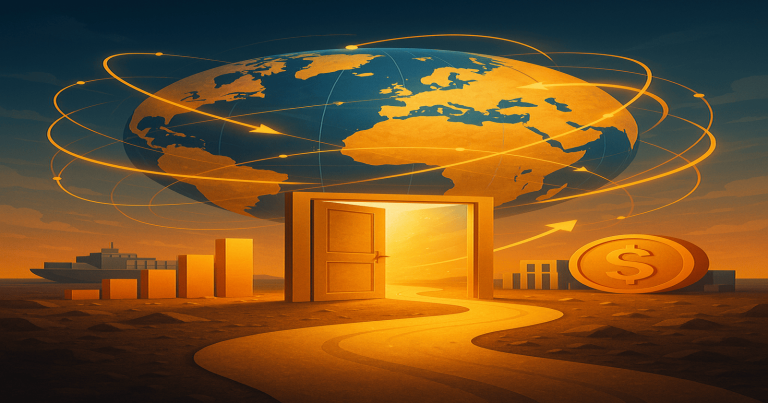An open economy is one that allows free trade and financial transactions with all other countries, rather than just engaging in the free flow of goods, services, and capital. Closed economies are the opposite of open economies in that they do not partake in international trade under any condition.An open economy is that model through which the nation provides for its system whereby goods, services, and capital flow in and out through a borderless frontier and with all the implications it makes according to the principles of international trade and investment where goods and services should move freely but have negligible restraints of significant ones like tariffs and quotas, or as opposed to one referred to as the closed economy in which imports and exports have fewer opportunities with imports. The open economy model promotes worldwide interaction, leading to specialization, innovation, and ultimately economic growth.Among the most important features of an open economy are its unrestricted trade policies, capital mobility, and global integration
What is Open Economy?
An open economy, in economic terms, is a country that may freely trade and transact internationally. Thus, this allows unwguarded movement of goods, services, and capital across borders. In an open economy, government generally avoids rigid restrictions such as tariffs and quotas to promote global trade and investment. It contrasts with a closed economy, where the country focuses on self-sufficiency and limits external economic activities.
An open economy is one that is not resistant to globalization because nations have economic, political, and cultural relations. Economically, this type of economy opens up avenues in specialization of production to where different nations specialize in whatever products or services they are well capable of producing. It creates the space for international competition, fostering cooperation and development. The advantage of an open economy is that it gives it access to larger markets, wider varieties of goods and services, and faster growth rates. The countries get access to foreign resources, techniques, and capital, which may not be available in their local area when the economy is open. Open economies often have faster development since they enjoy innovations and practices in the world market.
Typically, countries with open economies are part of international organizations and engage in free trade agreements that ease world trade among nations. At the same time, its risk factors include dependency on international markets, vulnerability to international economic trends, and job loss due to foreign and domestic competition.These key features of open economy enable countries to access foreign markets and resources, setting the foundation for global trade.The advantages of open economy include access to diverse products, advanced technologies, and improved living standards

How an Open Market Works?
To fully understand the features of open economy, it’s essential to explore how these characteristics function in real-world economic systems. An open market is free from restrictive barriers with supply and demand principles that operate it. In an open economy, the market has a platform for buyers and sellers from all over the globe to trade without excessive interference from the government. The government may regulate trade within some limits through customs duties or in the form of trade agreements; however, they do not try to impose barriers that suffocate the flow of goods and services.
In an open economy, businesses and consumers have the choice of buying and selling from across the globe. It ensures that consumers can enjoy multiple types of goods from other nations while businesses can access and use international markets to venture beyond their local reach. Open markets promote efficiency because there is competition, innovation, and consequently reduced prices. The increase in trade flow leads to specialization, where the countries focus on producing goods and services that they can produce most efficiently.
Components of Open Market Economy
Each of these components represents critical features of open economy, shaping how goods and services flow across borders. To understand how an open market works, let’s break it down into key components:
- Free Trade: An open market is based on free trade, which allows countries to purchase and sell goods and services across borders without heavy tariffs or restrictions.
- Specialization and Comparative Advantage: Countries can specialize in producing goods and services that they can produce most efficiently according to their comparative advantage. This enables them to trade those goods with others, thus enjoying the global supply chain.
- Global Supply Chain: Products from various countries are usually procured in an open market. A car might be designed in Germany, the parts may be manufactured in Japan, and the assembly would take place in the United States. A global supply chain helps to optimize resource allocation and minimize costs, thereby bringing down prices for consumers.
- Capital Mobility: Open economies open the floodgates for the free movement of capital. FDI and portfolio investments take place with much ease, resulting in more accessibility to the flow of finances, thereby aiding growth.
- Foreign Exchange Markets: The open economy possesses developed foreign exchange markets. It means currencies are traded; therefore, markets are critical because firms and people require currency exchange in international transactions.
These elements collectively contribute to the advantages of open economy, such as increased efficiency and economic growth
Example of Open Economy
To better understand the advantages of open economy, let’s examine how countries like the U.S., Singapore, and Germany benefit from global trade.There are several strong examples of open economy countries, including the United States, Singapore, and Germany. One of the most well-known open economies is that of the United States. The U.S. has a long history of promoting international trade and investment, with its policies largely favoring globalization and economic integration. The U.S. has agreements such as the North American Free Trade Agreement (NAFTA), now replaced by the United States-Mexico-Canada Agreement (USMCA), which promote free trade between its neighbors.
The other example is Singapore, which has a very open economy with few trade barriers. The country’s strategic location as a foremost trading hub in Southeast Asia and its open-door policy in foreign investment has made it one of the wealthiest nations in the world in terms of per capita income. Singapore’s Government focuses on creating a more business-friendly environment, offering tax incentives to foreign investors, and ensuring few restrictions on imports and exports.
Another country operating in an open economy framework is Germany. Being one of the largest exporters in the world, Germany has managed to take advantage of the open market principles with a strong industrial base and an emphasis on innovation. The European Union (EU), of which Germany is a member, is an example of economic integration in an open economy, with free movement of goods, services, people, and capital among the member countries.
Circular Flow of Income in an Open Economy
The circular flow of income is a primary concept in macroeconomics that describes how money, goods, services, and resources flow in an economy. In a closed economy, only households, firms, and government are in the flow. However, in an open economy, this flow introduces the foreign sector, where international trade, capital movements, and currency exchanges come into consideration within the economic system. The domestic income model therefore becomes by such modification a dynamic state interacting with the entire globe.
Four-Sector Circular Flow Model
The four fundamental groups thus make up the circular flow in an open economy:
- Households – Provides factors of production(labor, capital) and receives income.
- Firms- Produce goods/services and pay remuneration to households in the form of wages/rent/interest.
- Government- Collect taxes, give subsidies, and regulate economic activities.
- Foreign Sector- Interacts with the domestic economy through export-imports and capital flows.
The inclusion of the foreign sector introduces injections and leakages.
Injection and Leakage Explained
- Injections: Additions to the income flow in the economy. In an open economy, these are:
- Exports: Sales of domestic goods and services to foreigners
- Foreign Direct Investment: Capital inflow from overseas
- Remittances: Money earned abroad by nationals and sent back home
- Leakages: Deductions from the income flow in the economy, which are:
- Imports: Domestic expenditure on foreign goods and services
- Capital outflows: Domestic investors send money abroad
- Interest payments made to foreign lenders
An economy is said to be in equilibrium when Total Injections = Total Leakages. If the economy were to experience leakages greater than injections, it would face a trade deficit and thereby lower domestic income level.
Difference Between Closed and Open Economy
The following comparison highlights the distinct features of open economy in contrast to a closed economic model. An open economy is certainly a contrast to a closed one, with trade and interaction with the outside world very minimal or possibly nonexistent. For the wide impact that economic openness has on an economy, it is necessary to understand the difference between these two models of economics.
In a closed economy, the country aims to be self-reliant and does not trade with other countries or invest overseas. It relies more on domestic production to satisfy its population’s needs and limit its imports and exports. A closed economy may have high tariffs, tight controls of foreign goods, and low foreign investment that tends to strangle economic growth and innovation.
| Feature | Open Economy | Closed Economy |
| Trade | Engages in international trade with few restrictions | Focuses on domestic production with minimal trade |
| Investment | Encourages foreign direct investment (FDI) and capital flow | Limits foreign investments and capital flow |
| Government Role | Regulates trade but does not heavily intervene | Imposes heavy tariffs, quotas, and trade restrictions |
| Resource Allocation | Optimized through international trade and competition | Limited by domestic resources and capabilities |
| Economic Growth | Encourages growth through trade and innovation | Often slower, as innovation and competition are limited |
| Specialization | Countries specialize in goods they produce efficiently | Self-sufficiency is the goal, limiting specialization |
| Market Efficiency | Higher due to competition and access to global markets | Lower, due to reduced competition and limited market access |
The open economy model is generally considered more beneficial for fostering growth, innovation, and global cooperation. However, it requires careful management to mitigate the potential downsides, such as economic dependence on foreign markets and external shocks.
Open Economy FAQs
1. What is an open economy?
An open economy is one that trades with other countries and freely imports and exports goods, services, and money across borders. It adopts minimal trade restrictions and promotes economic integration with the global economy.
2. Define the major characteristics of an open economy.
The major characteristics of an open economy are free trade, capital mobility, foreign investments, currency exchange markets, and, as far as possible, few tariffs or quotas. These create avenues for international interaction and increased economic efficiency.
3. What are the benefits of an open economy?
An open economy avails to consumers various choices and sources of inputs that are present in significant amounts from other countries. This increases the levels of growth and product innovation within the economy. Competition will also exist, which may drive costs down.
4. An open economy may also get affected by a number of external factors.
Yes, open economies are often more vulnerable to changes in the global economy, such as recessions, disruptions in supply chains, and currency instability, though they also recover more quickly when the rest of the world rebound and investment-related inflows come their way.
5. Give examples of open economy countries.
Open economy countries include the U.S., Singapore, Germany, and those members of the European Union. These nations have been largely engaged in and still pursue international trade with favorable policies toward foreign investment and cooperation.


